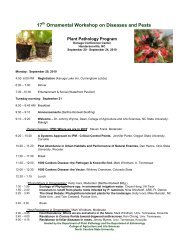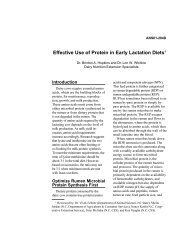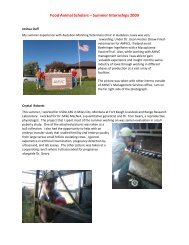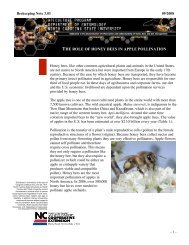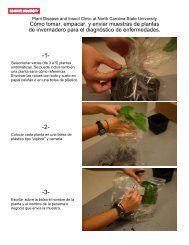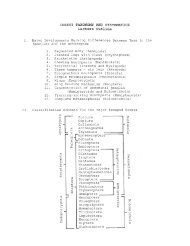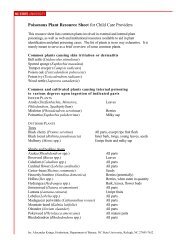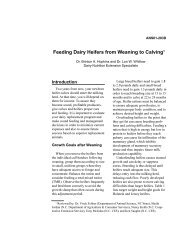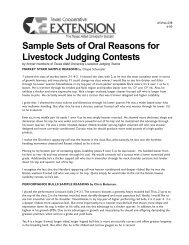2009 Junior Hippology IDs Answer Key
2009 Junior Hippology IDs Answer Key
2009 Junior Hippology IDs Answer Key
Create successful ePaper yourself
Turn your PDF publications into a flip-book with our unique Google optimized e-Paper software.
<strong>2009</strong> <strong>Junior</strong> <strong>Hippology</strong> ID’s ANSWER KEY<br />
NAME: ______________________________<br />
PARTICIPANT NUMBER:______________<br />
Carefully read each of the following questions, and enter the correct answer on your scantron<br />
sheet. Please completely fill in the space of your preferred answer on your scantron and<br />
circle your answer on this exam using a No. 2 pencil. Please make sure YOUR NAME and<br />
PARTICIPANT NUMBER are bubbled in correctly on your scantron and written on this<br />
exam. Good luck!<br />
51. What color pattern does this horse exhibit?<br />
A. leopard<br />
B. overo<br />
C. tobiano<br />
D. blanket<br />
E. roaning<br />
52. What kind of leg wrap is this and what is it used for?<br />
A. polo wrap; keeping legs warm<br />
B. exercise wrap; protects the leg during work<br />
C. standing wrap; keeps the leg from stocking up<br />
D. hock wrap; protects the hocks from rubs<br />
E. eventing wrap; protects the front legs during eventing<br />
53. What is the name of this bone in the horse’s hoof?<br />
A. long pastern bone<br />
B. short pastern bone<br />
C. cannon bone<br />
D. sesmoid bone<br />
E. coffin bone<br />
54. Name this part of the western saddle.<br />
A. skirt<br />
B. fender<br />
C. seat jockey<br />
D. swell<br />
E. cantle
55. What type of performance class would these shoes be used in?<br />
A. western pleasure<br />
B. western riding<br />
C. heading and heeling<br />
D. reining<br />
E. horsemanship<br />
56. What type of bit is this?<br />
A. full cheek snaffle bit<br />
B. eggbutt snaffle bit<br />
C. loose ring snaffle bit<br />
D. dee ring snaffle bit<br />
E. french link snaffle bit<br />
57. Identify this digestive tract organ.<br />
A. stomach<br />
B. small intestine<br />
C. esophagus<br />
D. cecum<br />
E. rectum<br />
58. What type of barn design is this?<br />
A. monitor<br />
B. shed row<br />
C. gambrel<br />
D. run in<br />
E. pole<br />
59. What is this piece of equipment called?<br />
A. dummy mare<br />
B. breeding phantom<br />
C. mounting block<br />
D. breeding stand<br />
E. teasing wall
60. Identify this skeletal bone.<br />
A. vertebrae<br />
B. scapula<br />
C. humerus<br />
D. phalanx<br />
E. sternum<br />
61. Identify this piece of equipment.<br />
A. figure-eight cavesson<br />
B. tiedown cavesson<br />
C. clincher cavesson<br />
D. tack cavesson<br />
E. flash cavesson<br />
62. What is this performance class called?<br />
A. cutting<br />
B. heading<br />
C. heeling<br />
D. roping<br />
E. dogging<br />
63. Identify the breed.<br />
A. Morgan<br />
B. Tennessee Walking Horse<br />
C. Thoroughbred<br />
D. Suffolk Punch<br />
E. Saddlebred
C B<br />
E<br />
D<br />
A<br />
64. Where is the correct location for determining heart rate?<br />
A<br />
B<br />
C<br />
D<br />
E<br />
65. Which of the following classes would this pattern be used for?<br />
A. showmanship<br />
B. western riding<br />
C. reining<br />
D. horsemanship<br />
E. hunter hack<br />
66. Identify this piece of equipment.<br />
A. hoof testers<br />
B. hoof rasp<br />
C. hoof nippers<br />
D. shoe clinchers<br />
E. alligator clinchers<br />
67. Name this blemish.<br />
A. bog spavin<br />
B. ring bone<br />
C. curb<br />
D. throughpin<br />
E. splint
68. Identify the breed<br />
A. Suffolk Punch<br />
B. Percheron<br />
C. Belgian Draft<br />
D. Clydesdale<br />
E. American Cream Draft<br />
69. What is this horse doing?<br />
A. yawning<br />
B. breathing<br />
C. exhibiting the Flehman response<br />
D. exhibiting the suckling reflex<br />
E. biting<br />
70. What is this piece of equipment used for?<br />
A. dragging arenas to “fluff” and smooth footing<br />
B. reseed pastures<br />
C. break up manure clumps in pastures<br />
D. answers B & C<br />
E. all of the above<br />
71. Identify this structure.<br />
A. deltoid<br />
B. deep digital flexor tendon<br />
C. latissimus dorsi<br />
D. femoral biceps<br />
E. external abdominal oblique<br />
72. What face markings does this horse exhibit?<br />
A. star, stripe, snip<br />
B. star and blaze<br />
C. bald face<br />
D. stripe only<br />
E. blaze
73. Identify this part of the English saddle.<br />
A. pommel<br />
B. stirrup<br />
C. cantle<br />
D. skirt<br />
E. waist<br />
74. Name this structural defect.<br />
A. pigeon-toed<br />
B. buck-kneed<br />
C. bandy-legged<br />
D. splay-footed<br />
E. cow-hocked<br />
75. Name this piece of equipment.<br />
A. splint boot<br />
B. ankle boot<br />
C. bell boot<br />
D. skid boot<br />
E. sport boot<br />
Congratulations! You have completed the <strong>2009</strong> <strong>Junior</strong> <strong>Hippology</strong> <strong>IDs</strong>. Please double check<br />
your answers. MAKE SURE YOUR NAME and PARTICIPANT NUMBER are written on<br />
this exam and are BUBBLED IN CORRECTLY on your scantron before turning everything<br />
in!



